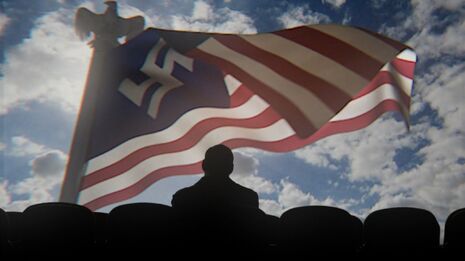TV Round-Up: The Man in the High Castle
Can Amazon Prime’s dystopian thriller make us sympathise with the Nazis? In the first of our fortnightly TV round up, Josh Kimblin finds out.

Ah, what a thing coincidence is. Of all the years to release a series about Nazis in New York, it had to be this one. In a year where fact and fiction have collided, the distance between this dystopian fiction and our reality feels nauseatingly small at times. It also makes The Man in the High Castle highly engaging television.
Adapted from Philip K. Dick’s novel, The Man in the High Castle posits an alternate historical reality in which the Axis powers of Nazi Germany and Imperial Japan won the Second World War and duly carved up the world between them. In a divided America, a band of resistance fighters lingers on, amidst growing tensions between the two superpowers. The Resistance seeks mysterious films, which show a possible future of atomic war between Nazis and the Japanese, or an alternate history where America won the war - namely, the audience’s reality.
The opening three episodes resume the narrative with the consequences of last season’s cliff-hanger finale. Juliana, our po-faced heroine, flees to the American Reich, having made enemies of both the Resistance and the Japanese authorities. Meanwhile Joe – her reluctant Nazi friend – travels to Berlin to confront his high-ranking father. Juliana’s erstwhile boyfriend, Frank, joins the Resistance while the authorities on both sides of the totalitarian divide edge closer to atomic war. Sounds confusing? That’s only half of it. Unfortunately for newcomers, series one is compulsory viewing.
“I let out a cry of nerdy delight when the vast domed interior of Albert Speer’s planned Reichstag building flashed across the screen. Amazon’s research department did their homework.”
However, the show’s greatest strength lies in its superb world-building, rather than its elaborate and occasionally uneven plot. The credibility of the premise relies on rendering the little details of dystopian life: the Japanese shopfronts in San Francisco; Nazi adverts in Times Square; or glimpses of Nazified kids television shows. The CGI-rendered Berlin is the best example, which gives history buffs a fascinating glimpse of what a victorious Nazi capital might have looked like. I let out a cry of nerdy delight when the vast domed interior of Albert Speer’s planned Reichstag building flashed across the screen. Amazon’s research department did their homework.
The other great strength is the complexity of the show’s supposedly ‘evil’ characters. Totalitarian ideologies often tempt screen-writers to present two-dimensional villains (*cough* Star Wars *cough*); cruel for cruelty’s sake and mildly deranged. Not so here. John Smith, an all-American SS officer played by an outstanding Rufus Sewell, is the most interesting character on screen. He shows how the American ideals of family and patriotism can fit seamlessly into the Nazi mindset. In one scene he kills people; in the next he is a loving suburban father who censures his children for teasing one another. The terminal illness of his son, which makes the boy a candidate for state euthanasia, promises a fascinating and deeply emotional conflict of interests.
There are problems, though. Primarily, the show suffers from a painful lack of humour. This was perhaps expected: euthanasia and totalitarianism aren’t prime comedic material. However, the lack of light relief means that the viewer rapidly becomes numb to the characters’ tribulations. When Ed gets tortured, or Juliana gets shot at, it becomes increasingly hard to respond with sympathy. It’s just another arbitrary cruelty. The second problem is in pacing. Lingering shots on Juliana’s invariably glum face wear a little, while the plot line involving Tagomi, the Japanese trade minister, has a great deal of screen time for very little development.
That said, for all its flaws, the show is worthy of praise. If you are in need of Christmas binge-watching, this should be your series of choice. As this year draws to a close, the sight of American high school children swearing allegiance to the Fuhrer has rarely seemed more appropriate
 Comment / Plastic pubs: the problem with Cambridge alehouses 5 January 2026
Comment / Plastic pubs: the problem with Cambridge alehouses 5 January 2026 News / Cambridge businesses concerned infrastructure delays will hurt growth5 January 2026
News / Cambridge businesses concerned infrastructure delays will hurt growth5 January 2026 News / Cambridge academics stand out in King’s 2026 Honours List2 January 2026
News / Cambridge academics stand out in King’s 2026 Honours List2 January 2026 News / AstraZeneca sues for £32 million over faulty construction at Cambridge Campus31 December 2025
News / AstraZeneca sues for £32 million over faulty construction at Cambridge Campus31 December 2025 Interviews / You don’t need to peak at Cambridge, says Robin Harding31 December 2025
Interviews / You don’t need to peak at Cambridge, says Robin Harding31 December 2025









